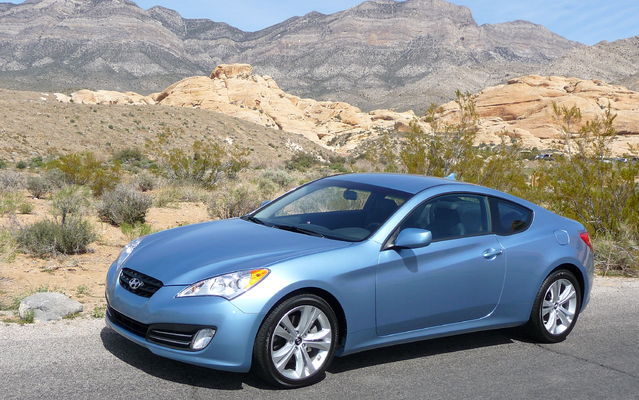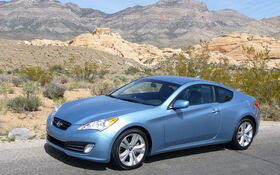2010 Hyundai Genesis Coupe: First the sedan, now the coupe
When Hyundai launched its luxury rear-wheel-drive sedan at the beginning of 2009, no one at the manufacturer would have expected it to gain such recognition, as it took home both Canadian Car of the Year and North American Car of the Year honours. Not too shabby for a manufacturer that is celebrating 25 years in Canada and began its career in our market with the miserable Pony (which nonetheless beat sales records from the start and had well-established manufacturers quaking in their boots).
And the number one Korean manufacturer has all kinds of ambition. It is currently the sixth-best selling automobile company in Canada and should pass Nissan by the end of the year if current trends continue. Indeed, Nissan’s sales have dropped 22% since the start of the year, while Hyundai’s sales have climbed 25%. And the Korean brand was already hot on the heels of the Franco-Japanese manufacturer in 2008.
But it would be wrong to think that this coupe is simply a two-door version of the sedan. Sure, it has the same platform with rear-wheel drive, but it has been adapted somewhat. For instance, the weight distribution, which was 50/50 on the sedan, is now 55/45. According to Hyundai’s engineers, that creates better accelerations and pick-up, which will make those who drive sportier cars happy. Furthermore, the front overhang is reduced compared to the sedan. Finally, the contours are more like those of the Tiburon than the Genesis sedan.
More refined design
The first Tiburon was successful as much for its shape than for its attractive performances, considering the asking price. In the case of the Genesis Coupe, although it has a different name, it is, in my opinion at least, the replacement for the Tiburon. What’s more, the stylists were inspired by the first when designing the second.
Right off the bat, I should note that this newcomer is 235 mm longer, with a wheelbase that is 290 mm longer, which ensures more comfort and better vehicle handling. Its use of 18-inch rims on the regular version and the optional 19-inch rims also helps give it more presence. With its plunging top and raised tail-end, this coupe respects the category’s aesthetic norms, but its head lights and the front grille are reminiscent of the Tiburon, and the Z-shaped line sculpted on the upper part of the side panel has stylists talking. It is also worth noting that the rear lateral window is lower than the body’s beltline, a feature that is unique to this car. Finally, the bulging rear wheel wells go perfectly with the car’s larger tail end.
No disrespect to the Hyundai logo, but I don’t find it particularly chic. And the fact that it is dead in the middle of the front grille doesn’t help matters. Small wonder why it isn’t on the Genesis sedan. The chrome slats on the front grille of the model with the V6 engine, which also features turn signals on the outer panel of the outside rearview mirrors, are some of the details distinguishing it from the base model.
The relatively elegant dashboard is made up of two ellipses separated by the brushed aluminum vertical central console that contrast with the black plastic of the dash. There is an information centre at the top of the central console that manages the audio system and the climate control. However, certain digits are hard to read. But the most unreadable thing on this dashboard is the trip computer placed in the lower part of the control for the dials. Not only is this little display panel low, but the blue-coloured digits are almost impossible to read without sunglasses. On a more positive note, the quality of materials and assembly is good. The front seats are comfortable and provide decent lateral support (though it’s not that impressive compared to some other sport coupes). They are easy to adjust and help you locate a good driving position. On the other hand, the steering wheel is not telescopic and the back seats are designed for people of smaller stature. As for the trunk, it is not as big as it should be, and its opening is quite small too. However, it’s easy to lower the seatbacks of the rear seats with the help of a release button.
Refined mechanics
There has been nothing but progress over the last quarter-century when you think of the Pony’s puny 4-cylinder carburetor engine! This coupe doesn’t have a V8 engine like the Genesis sedan, but there are two reasonably interesting powertrains. The base model comes with a 2.0-litre, four-cylinder, 210-hp engine featuring 223 lbs-ft of torque. Its power is enhanced by a turbo that has practically no lag. This dual-overhead cam engine with continuously variable valve timing teams up with either a six-speed manual gearbox or a five-speed automatic. This isn’t the only available engine, as the buyer will also be able to choose a 3.6-litre, 306 hp V6 that can go from 0-100 km/h in 6.3 seconds, some two seconds faster than the version with the 2.0-litre engine. Like the 2.0-litre version, it’s paired with a six-speed manual transmission. The available automatic gearbox is a six-speed, compared to the five-speed automatic transmission on the other version.
In both cases, there is a MacPherson strut front suspension and a multi-link independent rear suspension. Four-wheel disc brakes do the job, but if you opt for the GT version, offered with both engines, you will benefit from the braking power of Brembo monoblock four piston calliper brakes, plus very aggressive 19-inch Bridgestone Potenza RE050A tires, front strut tower braces, thicker stabilizer bars and firmer springs and shocks.
Sport or comfort
At first glance, it seems that the model with the V6 and the six-speed manual transmission is the sportier version. But behind the wheel, this combination turns out to be more like a Grand Touring than a pure sports car. Moreover, the V6 is smooth and linear, but it doesn’t have much punch despite a good acceleration time. In short, it’s smoother than it is responsive, and although the manual transmission features well selected gear ratios and precise shifting, it doesn’t necessarily help make it fun to drive. I prefer the six-speed automatic gearbox. But to be able to use the paddle shifters mounted behind the steering wheel, the stick shift has to be pushed to the left. It is also possible to shift manually using this same stick shift.
If you have the sporting spirit or you’re a ''tuner'' at heart, there is a good chance that you’ll like the version with the turbocharged engine. The car is slightly lighter, the gear ratio is good, and you won’t be disappointed by the four-cylinder engine. With the GT version and its Brembo brakes, it’s a very interesting combination for something like an autocross. What’s more, Hyundai Canada is convinced that this model will be highly sought after by those wanting to personalize their Genesis.
On the road, the car is stable, reasonably quiet and very predictable in curves. But even though the bigwigs at Hyundai maintain that the platform is 24 % more rigid than that of a BMW M3 coupe, it is exceedingly less fun to drive the Genesis, which nonetheless offers a combination of quality, performance and price that is tough to beat. Oh yeah, one more thing: on some of the road surfaces in Nevada where this test took place during the model presentation, the tires became extremely noisy. Fortunately, all the noise diminished once we left the concrete for the asphalt.
Basically, this Hyundai possesses many of the qualities needed to be successful and to make the leaders in the category – the Altima Coupe, Accord Coupe and even the Ford Mustang to an extent – concerned.












